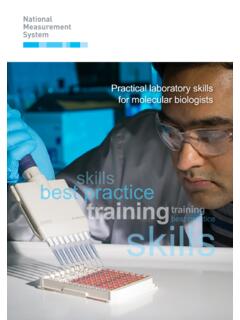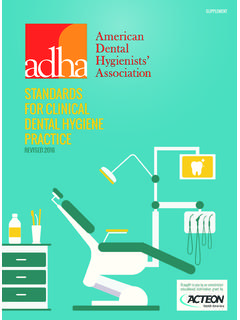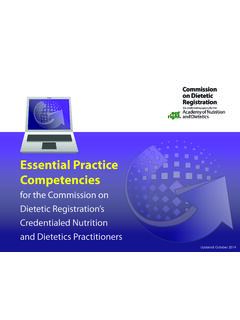Transcription of Skills handbook finalv3 - LGC Ltd
1 Laboratory Skills Training HandbookCharlotte BaileyVicki BarwickAMISBN 978-0-948926-25-9 Laboratory Skills Training handbook Charlotte Bailey Vicki Barwick May 2007 LGC Limited 2007 1 Introduction The need for a laboratory Skills training handbook Although analysis of samples is frequently carried out by using sophisticated instruments, the importance of basic laboratory Skills cannot be overlooked. The majority of instruments require calibration via the analysis of sets of calibration standards. It is therefore essential that analysts are able to prepare such solutions accurately. The analyst also needs to be able to handle and prepare samples correctly and be able to make routine measurements, such as measurements of pH, reliably.
2 Laboratories are increasingly being required to demonstrate the competence of their staff to carry out particular tasks and to document how competence was assessed. As well as sound practical Skills , analysts should have at least a basic understanding of important quality issues such as method validation , traceability and quality control. The aim of this handbook is to provide a basic training package in key laboratory Skills and to provide an introduction to important quality topics. Those responsible for training analysts can use the handbook to help plan training programmes. Trainees can use the handbook as a guide to best practice for a range of laboratory Skills and to gain a basic understanding of quality issues.
3 Structure of the handbook and how to use it This handbook is divided into two sections. Part A is aimed at the trainee analyst. Chapter A1 contains the essential health and safety information that analysts should be familiar with to enable them to work safely in the laboratory. It also covers the selection of test methods and equipment plus key aspects to consider when planning and carrying out an analysis. Chapter A2 covers sample handling and storage. Chapter A3 covers the key laboratory Skills that analysts need in order to be able to carry out analytical work with the required level of accuracy. There are questions relating to each skill to test understanding.
4 Chapter A4 introduces the key topics relating to quality assurance and quality control that analysts should be familiar with. Finally, Chapter A5 addresses data handling and reporting of results. Part B of the handbook is aimed at those responsible for planning and carrying out the training of analysts. For each of the key laboratory Skills covered in Chapter A3 there are key learning points, suggestions for assessing competence and observations which may indicate that retraining is required. A note about units of volume Volumes can be expressed in a number of different ways, cm3, mL, dm3, L. In this handbook we have used millilitres (mL) and litres (L) as the units of volume.
5 However, you may encounter cm3 and dm3 in other texts or standard operating procedures. Remember that 1 mL is equivalent to 1 cm3 and that 1 L is equivalent to 1 dm3 (and that 1 L contains 1000 mL). Acknowledgements Production of this handbook was supported under contract with the Department of Trade and Industry as part of the National Measurement System Valid Analytical Measurement (VAM) programme. The authors would like to thank everyone who provided suggestions on the content of the handbook , in particular, members of the VAM Clinical, Food, Industrial and LGC Limited 2007 Environment Reference Materials User Groups, and members of the ACB Education Committee.
6 We would also like to thank Pete Colwell (LGC), Andy Earls (LGC), Martyn Egerton (West Park Hospital, Epsom), Stephen Halloran (Royal Surrey County Hospital) and Elizabeth Prichard (LGC) for reviewing and commenting on drafts of the handbook . LGC Limited 2007 Contents PART A: INFORMATION FOR THE ANALYST 1 A1 WORKING IN THE LABORATORY 1 Health and safety issues 1 Method and equipment selection 4 Method selection 4 Equipment selection 5 The importance of standard operating procedures 6 Carrying out an analysis 7 A2 SAMPLE HANDLING AND STORAGE 9 Receiving samples 9 Labelling 9 Storage 10 Containers 10 Storage conditions 10 Sample tracking 11 A3 KEY LABORATORY Skills 12 Measuring volume 12 Types of equipment available 12 Markings on equipment used for volumetric measurements 15 Selecting a suitable piece of equipment 16 Cleaning glassware 18 Checking the accuracy of the volume of liquid contained in/delivered by the equipment 19 Checklists for making
7 Measurements of volume 20 Questions 25 Measuring mass 27 Mass versus weight 27 Types of balance available 27 Selecting a suitable balance 28 Checking the balance accuracy and set up 29 Correct use of balances for different applications 31 Checklist for making measurements of mass 34 Questions 35 Measuring pH 36 What is pH? 36 Equipment for measuring pH 37 Choosing a suitable electrode 38 Care of electrodes 40 Calibration of pH meters 42 Measuring the pH of the test sample 43 Checklist for making pH measurements using a pH meter 44 Questions 45 Preparing solutions of known concentration 46 When are solutions of known concentration used? 46 Calculating the concentration of solutions 47 Selecting a suitable material to prepare the solution 52 Practical steps in preparing solutions of known concentration 52 Labelling and storage of solutions 54 LGC Limited 2007 Checklist for preparing solutions of known concentration 55 Questions 57 Preparing reagent solutions 59 Calculating the concentration of reagent solutions 59 Preparing reagent solutions 60 Labelling and storage of reagent solutions 60 Checklist for preparing reagent solutions 61 Question 61 Carrying out a titration 63 Principles of titration 63 Carrying out a standardisation experiment 64 Detecting the end-point 64 Carrying out a titration 66 Titration
8 Calculations 68 Checklist for carrying out a titration 71 Questions 71 Centrifugation 73 What is centrifugation and when is it used? 73 rpm versus g 73 Different types of centrifuge 74 Correct operation of a centrifuge: safety and quality issues 77 Checklist for using a centrifuge 80 Questions 81 A4 QUALITY ISSUES 82 Definition of quality 82 Quality management, quality assurance and quality control 83 International quality standards 84 Method validation 85 Definition of validation 85 When is method validation required? 86 How much validation is required? 86 Method performance parameters 87 Calibration and traceability 92 Documenting test methods 95 Introduction to control charts 97 Proficiency testing and external quality assessment 98 Scoring systems in PT schemes 99 Evaluation of performance scores 100 Errors and uncertainty 100 Random errors 101 Systematic errors 101 Evaluating measurement uncertainty 101 Why is measurement uncertainty important?
9 104 A5 DATA HANDLING AND REPORTING RESULTS 105 Essential statistical terms 105 Units of measurement 107 Concentration expressed as a percentage 107 Concentration expressed as m/m or m/v 108 Concentration expressed as parts per million or parts per billion 108 Reporting results 109 LGC Limited 2007 Decimal places and significant figures 109 Rounding rules 111 Deciding the number of significant figures to report 112 Checking data 114 Questions 115 PART B: INFORMATION FOR THE SUPERVISOR 119 B1 ACCREDITATION REQUIREMENTS 119 B2 GENERAL APPROACH TO ASSESSING COMPETENCE 120 B3 KEY LABORATORY Skills 121 Measuring volume 121 Key learning points for measuring volume 121 Assessing competence in using volumetric glassware 123 Observations indicating that retraining may be required 124 Measuring mass 124 Key learning points for measuring mass 124 Assessing competence in making measurement of mass 125 Observations indicating that retraining may be required 125 Measuring pH 126 Key learning points for measuring pH 126 Assessing competence in making measurement of pH 126 Observations indicating that retraining may be required 126 Preparing solutions of
10 Known concentration 127 Key learning points for preparing solutions of known concentration 127 Assessing competence in preparing solutions of known concentration 127 Observations indicating that retraining may be required 128 Preparing reagent solutions 128 Key learning points for preparing reagent solutions 128 Assessing competence in preparing reagent solutions 129 Observations indicating that retraining may be required 129 Carrying out a titration 129 Key learning points for carrying out a titration 129 Assessing competence in carrying out a titration 130 Observations indicating that retraining may be required 130 Centrifugation 130 Key learning points for using a centrifuge 130 Assessing competence in using a centrifuge 131 Observations indicating that retraining may be required 131 APPENDIX 1: GLOSSARY OF TERMS 133 APPENDIX 2: ANSWERS TO QUESTIONS 137 APPENDIX 3: TRAINING RECORD 149 APPENDIX 4: ADDITIONAL RESOURCES 152 LGC Limited 2007 LGC Limited 2007 Part A Information for the analyst LGC Limited 2007 LGC Limited 2007 1 Part A: Information for the analyst A1 Working in the laboratory The laboratory is a potentially hazardous working environment.





